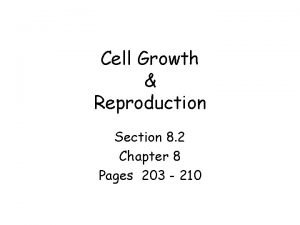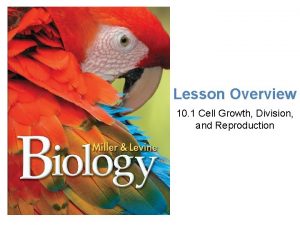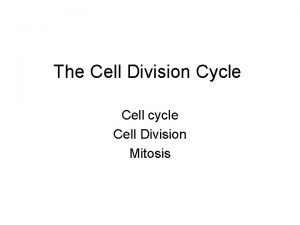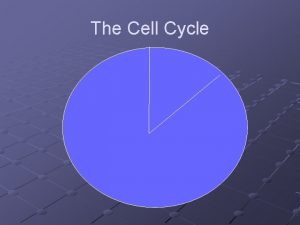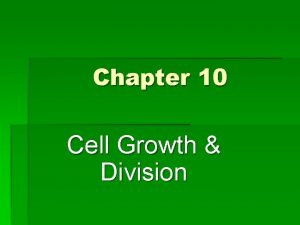Cell Growth and Division Introduction The cell cycle






- Slides: 6

Cell Growth and Division Introduction The cell cycle represents recurring events that take place in the period of time from the beginning of one cell division to the beginning of the next. In addition to cell division, the cell cycle includes periods when the cell is growing and actively producing materials it needs for the next division. 1. Why is the cell cycle called a cycle? 2. Why do you think that it is important for a cell to grow in size during its cell cycle? 3. What might happen to a cell if all events leading up to cell division took place as they should, but the cell did not divide?

Cell Growth and Division Explicit Instruction The cell cycle is the regular pattern of growth, DNA duplication, and cell division that occurs in eukaryotic cells. ◦ The cycle has four major stages: Gap 1, Synthesis, Gap 2, and Cell Division. ◦ During interphase the cell grows and duplicates its contents for each of its new “daughter” cells. ◦ There are three stages of Interphase: ◦ During G 1 (Gap 1) the cell carries out normal functions, grows in size and duplicates its organelles. ◦ During S (Synthesis) stage the cell duplicates its chromosomes. ◦ During G 2 (Gap 2) additional cell growth occurs while the cell prepares for cell division.

Cell Growth and Division Explicit Instruction Mitosis is divided up into four stages ◦ Prophase ◦ Chromosomes condense, nucleus disappears and spindle apparatus forms ◦ Metaphase ◦ Chromosomes align along equator (metaphase plate) of cell ◦ Anaphase ◦ Sister chromatids separate and cytokinesis (the division of the cytoplasm) begins ◦ Telophase ◦ Nuclear reassembles, chromosomes decondense, spindle fibers disappears, and cytokinesis completes

Cell Growth and Division Explicit Instruction Cancer occurs when the regulation of cell division breaks down. ◦ Errors may be inherited genetic errors or due to exposure to radiation or chemicals. ◦ Cancer cells form tumors that may metastasize to other parts of the body. ◦ In benign tumors, the cancer cells remain clustered together. ◦ In malignant tumors, cancer cells can break away from the tumor. ◦ Cancer cells that break away can form new tumors in other areas of the body.

Cell Growth and Division Guided Practice Mistakes during cell division: 1. What might happen if the steps of prophase did not correctly take place and division continued? 2. What might happen if the steps of metaphase did not correctly take place and division continued? 3. What might happen if the steps of anaphase did not correctly take place and division continued? 4. What might happen if the steps of telophase did not correctly take place and division continued? 5. What might happen if the steps of cytokinesis did not correctly take place and division continued?

Cell Growth and Division Independent Practice 1. Why is it important for each checkpoint to be completed before moving to the next part of the cell cycle? 2. Explain specific processes that change in a normal cell, causing a transform into a cancerous cell. 3. Why is careful regulation of the cell cycle important to multicellular organisms?



